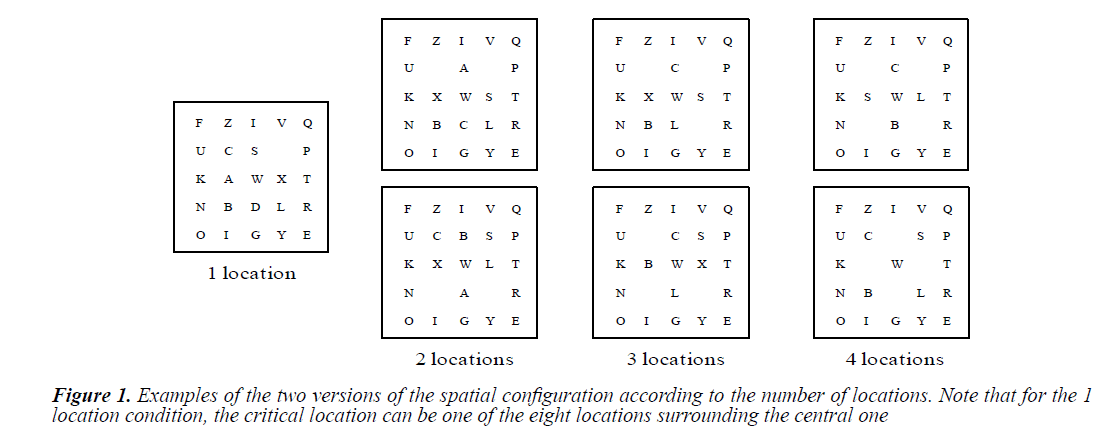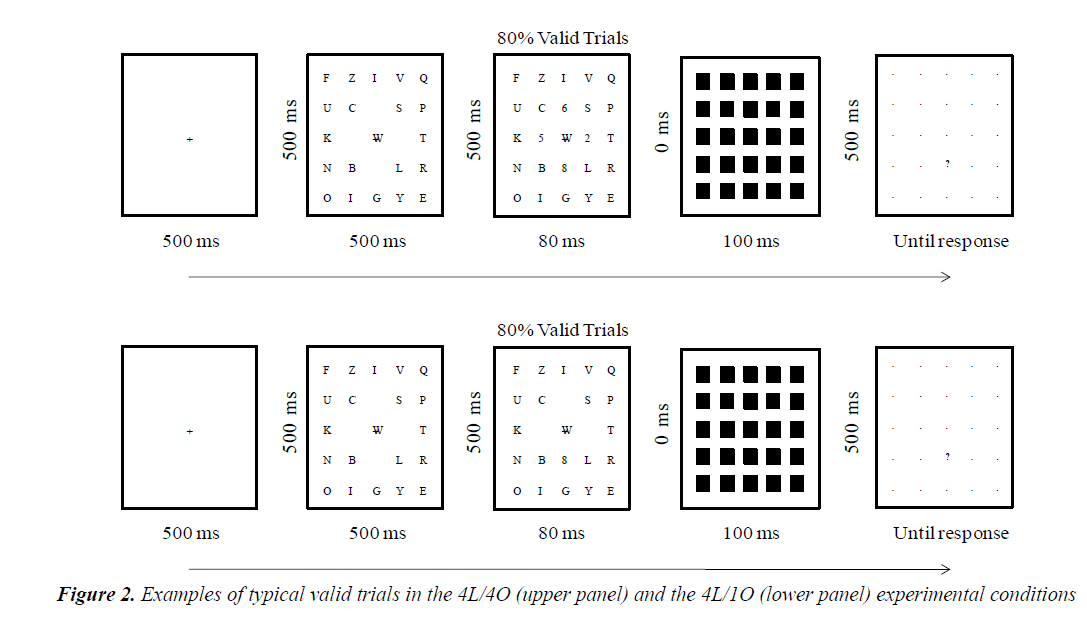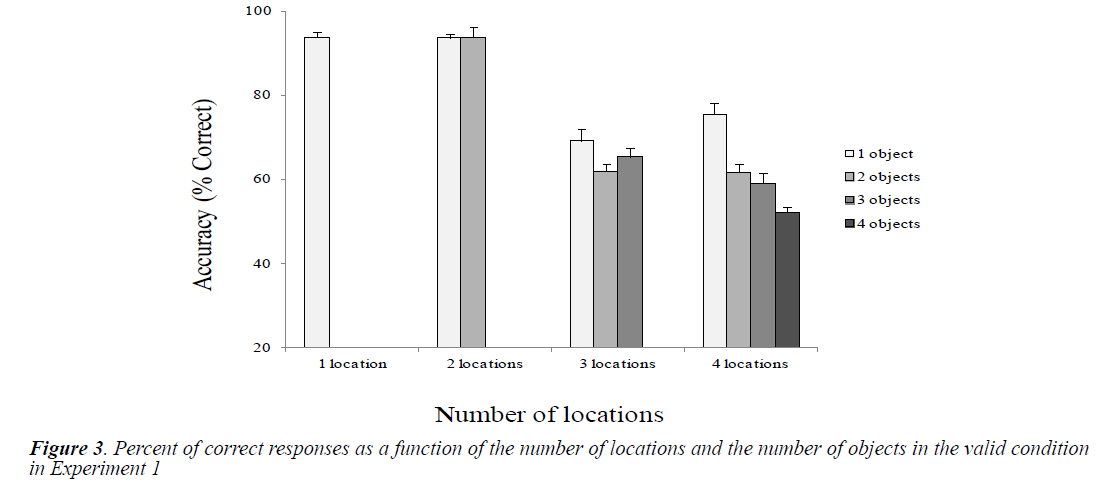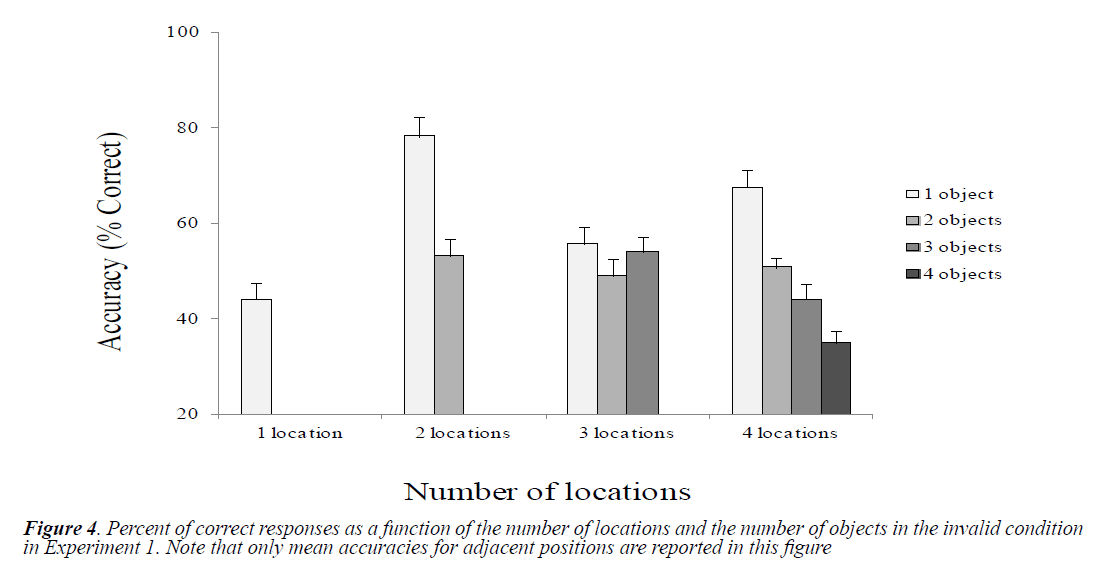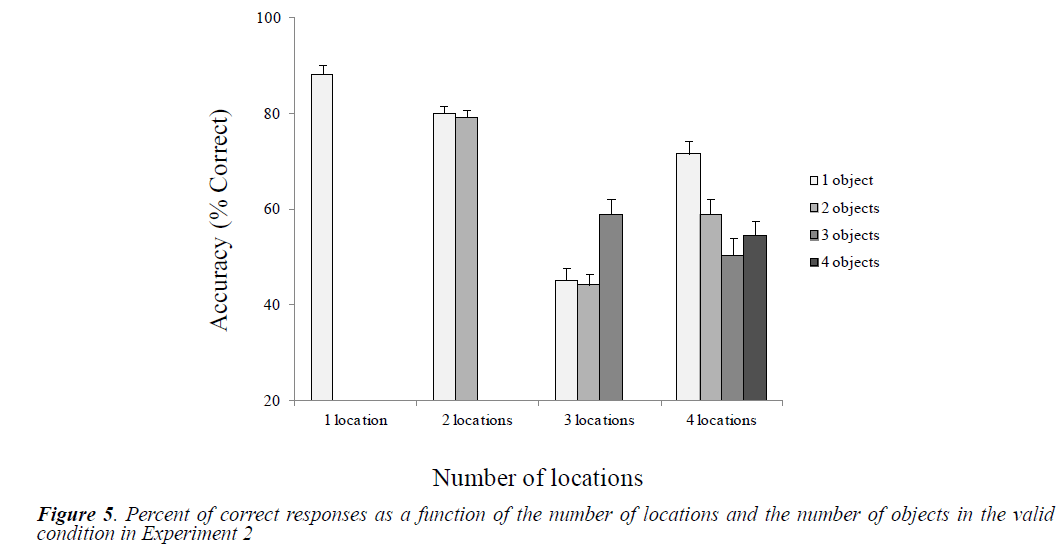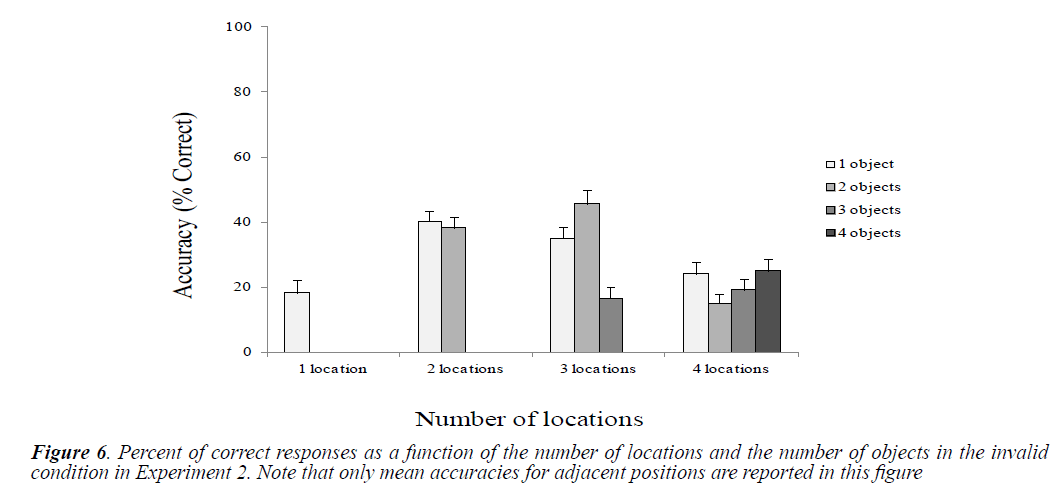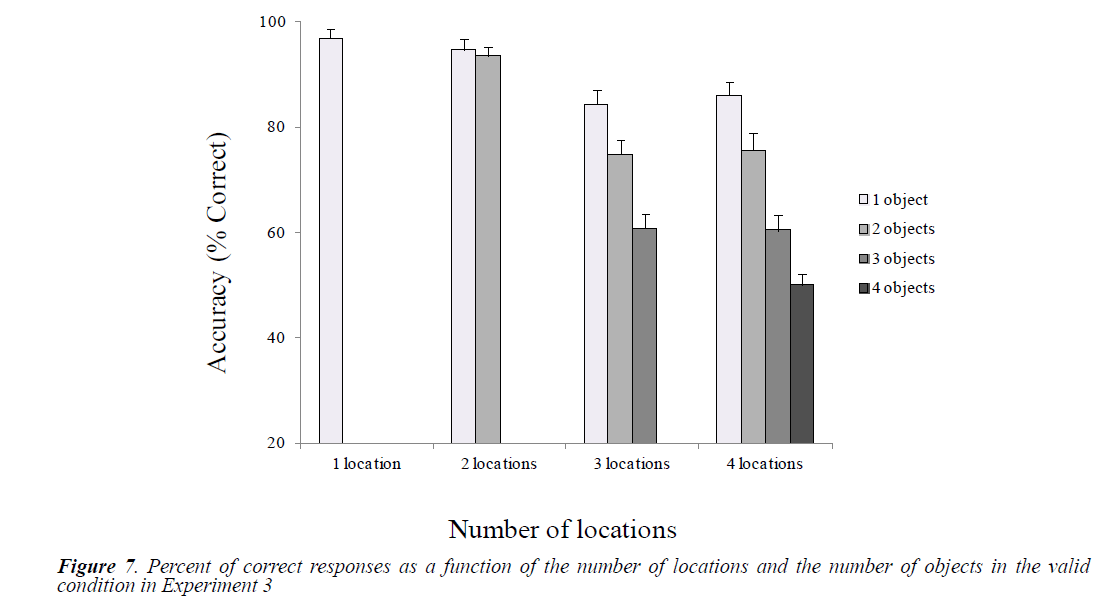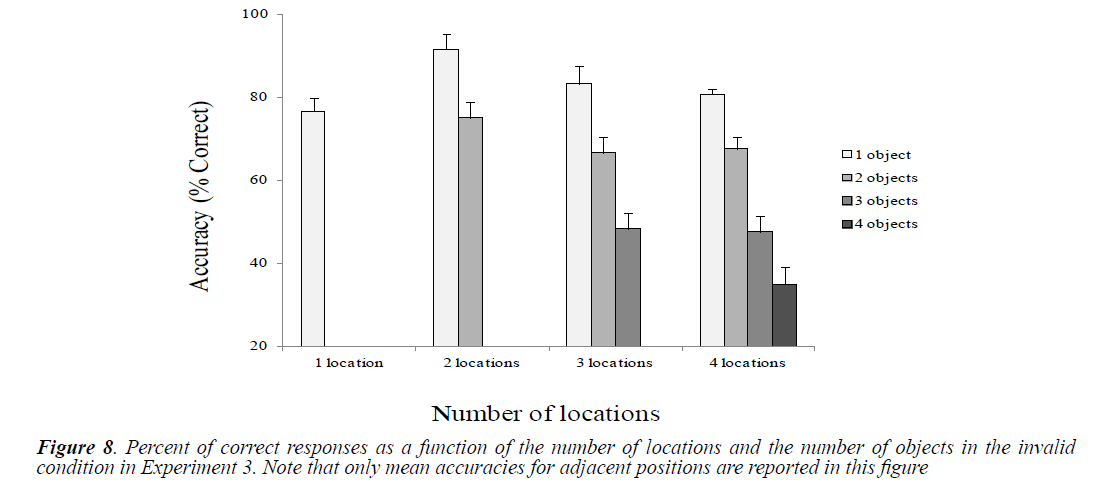Research Article - Journal of Psychology and Cognition (2016) Volume 1, Issue 1
Effects of the number of objects and locations on attentional allocation and processing in a visual short-term memory task.
Aymen Ben Abbes1, Yousri Marzouki2,3 and Thierry Ripoll2
1University of Tunis El Manar (Institut Supérieur des Sciences Humaines de Tunis), Tunisia.
2Aix-Marseille Université (Laboratoire de Psychologie Cognitive, CNRS) Marseille, France.
3Qatar University, Doha, Qatar.
- *Corresponding Author:
- Yousri Marzouki
Laboratoire de Psychologie Cognitive
Aix-Marseille Université, 3 place Victor Hugo
13331 Marseille, France.
Tel: +33 4 13 55 09 73
E-mail: yousri.marzouki@univ-amu.fr
Accepted date: October 07, 2016
DOI: 10.35841/psychology-cognition.1.1.40-56
Visit for more related articles at Journal of Psychology and CognitionAbstract
Using a partial report procedure, we tried to dissociate the effect of increasing the number of attended locations from that of increasing the number of objects (digits) appearing in these locations. Participants had to allocate their attention to different locations among a set of distractors (letters). After a delay of 500 ms they had to process either one, two, three or four digits appearing at one, two, three or four previewed locations. We found that the capacity of attentional allocation over locations decreased at three attended locations and also after the increase in the number of objects while attending to four locations. The same procedure was used in Experiment 2, except that digits were used as distractors to eliminate the possible attentional re-allocation bias towards targets during the processing phase. We introduced in Experiment 3 a color contrast between targets and distractors in order to facilitate their discrimination and to reduce the spatial configuration effect of locations. The results are in line with Experiment 1 findings and showed that the processing of multiple objects is constrained by two interacting difficulties. The first relies on resources distribution over the attended locations whereas the second relies on parallel encoding of objects.
Keywords
Attentional allocation, Division of attention, Capacity threshold.
Introduction
Our visual system is continuously flooded by a huge amount of information, which constantly challenges the way we allocate our attention over space when we simultaneously select and process the most relevant "items". The most popular description in literature of the attentional allocation is the “spotlight” metaphor, which suggests that attention can operate as a beam toward a circumscribed location in order to enhance information processing at this particular position [1,2]. It has been assumed that performance can be significantly damaged when the visual system has to attend to many locations simultaneously due to the cost induced by distributing attention over different locations [3,4]. However, a growing substantial body of data suggests that spatial attention deployment allows the participants to pay attention to non-contiguous locations or objects while they inhibit irrelevant positions or objects interposed between them [5-8]. For example, Awh and Pashler used a partial report technique in which observers had to systematically report the identity of two targets presented at separate locations within a 5-by-5 stimulus matrix [5]. There was a valid condition in which two targets appeared at previously cued locations. In the invalid condition, one of the two targets appeared directly between the cued locations (the medial position). The authors found a strong capacity to attend to the cued locations without selecting the intervening ones. Whatever the conclusions made by these investigations, their main aim was to test the capacity to select targets among distractors and to process these targets simultaneously (detection, identification, memorization, etc.). Accordingly, the performance was contingent upon two sequential difficulties: firstly, the participants had to attend to the critical locations of targets to extract them from distractors, and secondly, they had to encode the properties of targets to enable their full representation. However, even if these two distinctive difficulties had been underlined in some studies [9-11], there was no systematic dissociation between them in the above-mentioned research.
Xu and Chun provided an interesting framework addressing this issue called the neural object-file theory. The latter highlighted the presence of two stages of processing: the object individuation and the object identification. In the first stage objects are individuated and selected from a visual scene and in the second stage objects are encoded and processed by higher visual areas. The authors stated also that this individuation-identification framework requires two distinct stages that are not necessarily separate to guarantee an efficient processing. Most important to our study, Xu and Chun claimed that given the capacity limitation in both individuation and identification processes and in order to process a complex visual scene with multiple objects, visual attention needs to be shifted to different part of the scene [11].
However, in Huang and Pashler, Kraft et al. and Xu and Chun, studies no specific information was provided about the particular difficulties in attentional deployment over many locations, on the one hand, and those related to the multiple processing of targets, on the other [9-11]. Generally, these two sequential difficulties (or costs) have been mapped together without considering performance fluctuation when i) the number of attended spatial locations increases and ii) the subsequent increase of perceptual load under the effect of an increasing number of objects. Stated differently, the attentional distribution over many positions in space in order to optimize the selection of one object is different from the situation in which we must split our attention into many locations in order to process all objects appearing in these locations. In the latter case, there is an initial difficulty of dividing attention over locations and a subsequent one linked to the multiple encoding of objects.
In the present work, we sought to empirically dissociate these two types of difficulties. To do so, we used a partial report paradigm, largely inspired by Awh and Pashler study, by which we manipulated separately the number of locations and the number of objects [5]. Our aim was twofold: i) to determine the cost generated by increasing the number of locations on which depends the attentional selective allocation capacity, and ii) to determine the cost resulting from the increase in the number of objects, which is related to processing capacity. The selective cost was assessed by comparing reporting performance when allocating attention to one, two, three or four locations, apart from the number of objects that could appear in them. The processing cost was estimated by contrasting the reporting performance with one, two, three or four objects.
In our task, observers previewed an array of distractors and had to allocate their attention to specific empty spots in the array corresponding to locations in which targets were most likely to appear. The number of these empty locations varied from one to four. This same array disappeared and reappeared with digits (targets) that occupied the previously empty locations. The number of these digits also varied from one to four, and observers had to report the identity of one of them. Making predictions based on these separate manipulations of number of locations and objects could be difficult, because no systematic variation of these factors had been done in previous research. However, one may expect additive effects of both factors, in which case a linear decrease in performance would be observed as the number of attended locations and the number of processed targets increase. We could also predict that each increase in the number of locations could lead to a loss in performance, which would be emphasized as the number of objects increases. For example, when we moved from two to three locations or from three to four locations, we could expect a decrease in performance due essentially to the growing difficulty in maintaining attention at these locations. Moreover, with a fixed number of locations (two, three or four), increasing the number of objects that could appear in them could be accompanied by a supplementary loss of performance. In the second case, we could expect a linear decrease in performance only as the number of locations decreases or only as the number of objects increases. Performance could be basically contingent upon the difficulty in maintaining attention over many locations and less sensitive to the increase in the number of objects. Conversely, it could be slightly dependent on the number of attended locations but much sensitive to the increase in the number of objects. A final possible prediction could be the possible effect of the number of objects when a certain number of attended locations is reached. In such a case, we would observe a non-linear decrease in performance because of an interaction of the two factors.
Experiment 1
Method
Participants: Ten students from Aix-Marseille University participated in the experiment. All reported having normal or corrected-to-normal vision without visual or neurological problems.
Stimuli and design: The experiment was displayed on a 14-inch computer screen and was controlled using E-Prime 2.0 software® [12]. The participants were tested individually in a dimly lit room. They were seated at a viewing distance of about 70 cm from the computer screen. The number of locations (1, 2, 3 and 4) was crossed with the number of objects (1, 2, 3 and 4) in a within-subjects design as shown in Table 1. 1 location/1 object (1L/1O), 2 locations/1 object (2L/1O), 2 locations/2 objects (2L/2O), 3 locations/1 object (3L/1O), 3 locations/2 objects (3L/2O), 3 locations/3 objects (3L/3O), 4 locations/1 object (4L/1O), 4 locations/2 objects (4L/2O), 4 locations/3 objects (4L/3O), and 4 locations/4 objects (4L/4O). Note the unbalanced structure of the design. This manipulation provided accurate information about the relative cost of each factor. Such cost was considered very low when the participants were confronted with 1 location/1 object and very high when they had to attend to 4 locations/4 objects.
| 1 Object | 2 Objects | 3 Objects | 4 Objects | |
|---|---|---|---|---|
| 1 location | ||||
| 2 locations | ||||
| 3 locations | ||||
| 4 locations |
Table 1. The non-orthogonal structure of the experimental design.
All stimuli were presented within a centrally placed 5 × 5 array of evenly spaced positions. Each stimulus subtends approximately 6.36° on each side from the central fixation. Letters and digits appearing within these locations were approximately 1.27 cm tall and 1.02 cm wide. The visual angle for stimuli appearing within the central 3 × 3 portion of the array was estimated at 3.2°. Apart from the one location condition in which the digit appeared at one of the eight positions surrounding the central positions, two different spatial configurations were used for each location condition (Figure 1).
During all trials, the stimulus array contained 21 uppercase letters and 1, 2, 3 or 4 digits. This set of letters (from the 26 letters of the alphabet) and digits (from 1 to 9) was randomly sampled without replacement. All stimuli were presented as black objects against a white background.
Procedure
Prior to the experiment, the participants performed a practice session containing 24 trials; this was followed by 600 experimental trials presented randomly. At the beginning of each trial, a fixation point was presented at the center of the screen (Figure 2). The participants were instructed to focus their gaze on this fixation during the trial. Each trial began by pressing the space-bar button. After an interval of 500 ms, the distractors appeared for 500 ms and the participants were instructed to focus their attention on the empty locations presented in this array, because they were more likely to be occupied by targets. These locations always appeared within the central 3 × 3 portion of the 5 × 5 array. This manipulation aimed to equilibrate lateral masking for each of the nine critical locations (and so targets). Five hundred milliseconds after the offset of this array, the critical array containing distractors and targets appeared for 80 ms. This exposure time was sufficient to prevent eye movements or attentional switching between targets. A total of 480 valid trials (80%) and 120 invalid trials (20%) were randomized during the experiment. The 480 valid trials were evenly divided by ten experimental conditions (48 trials/condition). The same goes with 120 invalid trials (12 trials/condition). In the invalid conditions, digits did not appear in the previewed empty locations 20% of the time and only appear at adjacent or distant locations from the previewed ones within the 3 × 3 array matrix. On invalid trials, the locations of targets varied according to experimental conditions. In the 1L/1O condition, the target appeared adjacent to the previously empty location or distant from it. In the 2L/1O and 2L/2O conditions, the target (s) appeared directly between the two previously empty locations (adjacent position condition) or distant from them. In the 3L/1O, 3L/2O, 3L/3O, 4L/1O, 4L/2O, 4L/3O and 4L/4O conditions, the target (s) only appeared adjacent to the previously empty locations; the absence of a distant position condition was due to the specific spatial configuration wherein three or four locations were used, which did not allow locating targets at positions contiguous to previously empty locations. Immediately after the offset of the critical array, a masking array (composed of 25 black squares) occluded the entire 5 × 5 grid for 100 ms. Finally, after 500 ms, the masking array was replaced by a 5 × 5 grid of dots and a post-cue question mark that indicated where one of the targets had appeared. The post-cue also ensured that the participants were accurately informed of target location even during invalid trials. At this level, the participants made an “unspeeded” report of the identity of the target digit by pressing one of the keyboard numeric pad buttons from 1 to 9. After this, a new trial began.
| Number of Locations | Number of Objects | Experimental Condition | Means | ||
|---|---|---|---|---|---|
| Valid | Invalid | ||||
| Adjacent Position | Distant Position | ||||
| 1 | 1 | 93.1 ± 1.2 | 44.1 ± 3.4 | 38.3 ± 4.1 | 58.7 ± 2.9 |
| 2 | 1 | 93.7 ± 0.9 | 78.3 ± 4.1 | 53.3 ± 3.4 | 75.1 ± 2.8 |
| 2 | 93.9 ± 1.5 | 53.3 ± 3.1 | 23.3 ± 2.8 | 56.8 ± 2.4 | |
| 3 | 1 | 69.1 ± 2.8 | 55.8 ± 3.4 | / | 62.4 ± 3.1 |
| 2 | 61.8 ± 2.2 | 49.1 ± 3.4 | / | 55.4 ± 2.8 | |
| 3 | 65.4 ± 2.2 | 54.1 ± 2.5 | / | 59.7 ± 2.3 | |
| 4 | 1 | 75.4 ± 2.8 | 67.5 ± 3.8 | / | 71.4 ± 3.3 |
| 2 | 61.6 ± 1.9 | 50.8 ± 1.9 | / | 56.2 ± 1.9 | |
| 3 | 59.1 ± 2.2 | 44.1 ± 3.1 | / | 51.6 ± 2.6 | |
| 4 | 52.2 ± 1.2 | 35 ± 2.5 | / | 43.6 ± 1.8 | |
| Means | 72.6 ± 1.9 | 45.7 ± 3.1 | |||
Table 2. Percent of correct responses as a function of the number of locations, the number of objects and experimental conditions in Experiment 1 (Mean ± standard errors).
Results
The percentage of correct responses was calculated for each condition. Table 2 reports the mean accuracies.
Given the non-orthogonality of the design and the withinsubjects procedure used in this experiment with different participants, it was necessary to explicitly take into account the possible random effects of participants on the accuracy of the data. Thus, we performed a multilevel regression analysis on the accuracy of the data using the linear mixed-effect (LME) model technique [13-15], which is currently becoming the standard technique to analyze this type of data [16,17]. This enabled us to consider fixed and random effects simultaneously in greater detail than possible with traditional by item/by participant averaging. Moreover, the LME technique allowed us to robustly test simple effects and interactions from an unbalanced design.
Mean accuracies were calculated as a function of number of locations, number of objects, and validity. The LME analysis revealed significant main effects of number of locations, [t (5816)=-7.75, p<0.0001] (Whereas denotes the degrees of freedom calculated under the multi-level model's assumptions were confirmed using a Markov Chain Monte Carlo sampling approach [13]), number of objects, [t (5816)=-3.28, p<0.0005], and validity [t (5816)=-6.99, p<0.0001]. We observed a significant interaction between number of locations and number of objects, [t (5816)=2.98, p<0.005]. There was also a significant interaction between number of locations and validity [t (5816)=6.09, p<0.0001] and between number of objects and validity [t (5816)=2.76, p<0.01]. The triple interaction between the three factors was significant [t (5816)=-2.98, p<0.01].
We further investigated the possible presence of mixed effects (i.e., random slopes) between number of locations and participants and between number of objects and participants. We did not find any evidence for significant individual differences across participants in the magnitude of the effects of number of locations or number of objects (ps>0.1). Hence, there was no reason to consider individual results separately, instead of the whole group of participants.
Effects of the Number of Locations and the Number of Objects in the Valid Condition
Figure 3 shows the mean accuracies as a function of the number of locations and objects in the valid condition.
We examined differences between conditions related to the number of locations and the number of objects by performing paired t comparisons. Table 3 shows the results. Globally, we observed a significant decline in performance in conditions of three and four locations compared with that in conditions of one and two locations. Surprisingly, with one object, performance was higher in the four-location condition than in the three-location condition. Regarding the effect of number of objects, there was a linear decrease in performance only in the four-location condition.
The very significant performance drop in 3-location condition is not linear. When moving from two to three locations, the performance seemed to cross an important threshold in terms of difficulty to allocate the divided attention but not in terms of processing difficulty. Whereas from three to four locations, we cannot say that the difficulty of attentional allocation has increased (no difference for the 3-location condition for 1, 2 and 3 objects.
| Number of locations analysis | Number of objects analysis | ||||||||
|---|---|---|---|---|---|---|---|---|---|
| Conditions | t (9) | p | d | Conditions | t (9) | p | d | ||
| 1L/1O Vs. 2L/1O | 0.2 | 0.84 | 0.182 | 2L/1O Vs. 2L/2O | -0.24 | 0.811 | -0.159 | ||
| 1L/1O Vs. 3L/1O | 6.3 | <0.001* | 12.098 | 3L/1O Vs. 3L/2O | 1.89 | 0.9 | 2.891 | ||
| 1L/1O Vs. 4L/1O | 5.24 | <0.001* | 9.024 | 3L/1O Vs. 3L/3O | 0.94 | 0.367 | 1.465 | ||
| 2L/1O Vs. 3L/1O | 6.46 | <0.001* | 13.016 | 3L/2O Vs. 3L/3O | -1.18 | 0.265 | -1.629 | ||
| 2L/1O Vs. 4L/1O | 5.34 | <0.001* | 9.683 | 4L/1O Vs. 4L/2O | 3.07 | <0.05* | 5.835 | ||
| 3L/1O Vs. 4L/1O | -3.4 | <0.001* | -2.218 | 4L/1O Vs. 4L/3O | 5.37 | <0.001* | 6.455 | ||
| 2L/2O Vs. 3L/2O | 8.54 | <0.001* | 16.93 | 4L/1O Vs. 4L/4O | 7.96 | <0.001* | 11.317 | ||
| 2L/2O Vs. 4L/2O | 7.07 | <0.001* | 18.617 | 4L/2O Vs. 4L/3O | 0.9 | 0.388 | 1.22 | ||
| 3L/2O Vs. 4L/2O | 0.06 | 0.952 | 0.098 | 4L/2O Vs. 4L/4O | 3.16 | <0.050* | 5.968 | ||
| 3L/3O Vs. 4L/3O | 2.64 | <0.050* | 2.851 | 4L/3O Vs. 4L/4O | 3.58 | <0.010* | 3.977 | ||
Table 3. Paired t comparisons between experimental conditions in the valid condition in Experiment 1.
Effects of the Number of Locations and the Number of Objects in the Invalid Condition
Figure 4 shows the mean accuracies as a function of the number of locations and objects in the invalid condition.
We analyzed differences between the conditions related to the number of locations and the number of objects by performing paired t tests. Table 4 presents the results. The most noticeable effect was the low accuracy in the one-location condition, particularly compared with the two-location condition (with one object). Moreover, we observed a linear decrease in performance as the number of objects increased in the two-location and four-location conditions, but we observed no such effect in the threelocation condition. We found that the targets presented at adjacent invalid positions were better reported than those presented at distant invalid positions, except for the 1L/1O condition, in which no significant difference was observed: adjacent position (1L/1O) vs. distant position (1L/1O), t (9)=0.76, p=0.46; adjacent position (2L/1O) vs. distant position (2L/1O), t (9)=2.24, p=0.05; adjacent position (2L/2O) vs. distant position (2L/2O), t (9)=4.63, p<0.005.
| Number of locations analysis | Number of objects analysis | ||||||||
| Conditions | t (9) | p | d | Conditions | t (9) | p | d | ||
|---|---|---|---|---|---|---|---|---|---|
| 1L/1O Vs. 2L/1O | -3.32 | <0.010* | -9.024 | 2L/1O Vs. 2L/2O | 2.49 | <0.050* | 6.878 | ||
| 1L/1O Vs. 3L/1O | -1.7 | 0.121 | -3.372 | 3L/1O Vs. 3L/2O | 1.39 | 0.196 | 1.931 | ||
| 1L/1O Vs. 4L/1O | -4.11 | <0.001* | -6.446 | 3L/1O Vs. 3L/3O | 0.22 | 0.825 | 0.568 | ||
| 2L/1O Vs. 3L/1O | 2.29 | <0.050* | 5.937 | 3L/2O Vs. 3L/3O | -1.2 | 0.259 | -1.669 | ||
| 2L/1O Vs. 4L/1O | 1.27 | 0.235 | 2.734 | 4L/1O Vs. 4L/2O | 3.07 | <0.050* | 5.88 | ||
| 3L/1O Vs. 4L/1O | -3.29 | <0.050* | -3.223 | 4L/1O Vs. 4L/3O | 3.18 | <0.050* | 6.734 | ||
| 2L/2O Vs. 3L/2O | 1.16 | 0.272 | 1.267 | 4L/1O Vs. 4L/4O | 6.35 | <0.001* | 10.301 | ||
| 2L/2O Vs. 4L/2O | 0.41 | 0.684 | 0.99 | 4L/2O Vs. 4L/3O | 1.56 | 0.152 | 2.653 | ||
| 3L/2O Vs. 4L/2O | -0.36 | 0.726 | -0.634 | 4L/2O Vs. 4L/4O | 4.66 | <0.005* | 7.166 | ||
| 3L/3O Vs. 4L/3O | 2.88 | <0.050* | 3.521 | 4L/3O Vs. 4L/4O | 2.28 | <0.050* | 3.204 | ||
Table 4. Paired t comparisons between experimental conditions in the invalid condition in Experiment 1.
Discussion
The results from Experiment 1 clearly showed dissociation between the impact of the number of locations on the selection and the number of objects on the processing. Hence, the appearance of digit targets in the attended locations allowed them to be processed as a different category relative to the letter stimuli used as distractors making the attention to be re-allocated toward them. Such hypothesis can be supported by the demonstrated targetflanker congruity effect according to which there is a reduced flanker (i.e., distractor) effect when distractors were semantically different from targets [18-22]. Thus, we cannot rule out the possibility that the processing operation involved in Experiment 1 may be facilitated by a kind of object-based attentional allocation that occurred during the targets display.
Experiment 2
Experiment 2 aimed to eliminate the possible attentional re-allocation bias towards targets during the processing phase. Therefore, we used the same experimental manipulation as in Experiment 1 except that digits were used as distractors instead of letters. In doing so, we sought to limit the attentional allocation process to the duration of locations' display. Consequently, the manipulation of objects would exclusively reflect the cost linked to their multiple processing since no facilitation based upon an extra-location effect would be allowed during objects processing.
We have showed in Experiment 1 that the attentional reallocation towards targets enhanced the amount of resources attributed to their locations, whereas no such possibility can occur in Experiment 2. Moreover, the sizable validity effect across all conditions in Experiment 1 can be attributed to the contrast category effect (digits vs. letters) especially when targets appeared in invalid locations. The latter entailed more attentional attraction to their locations and an increase in the capacity to process them. On the contrary, distractors and targets in Experiment 2 belong to the same category (all digits) which could weaken such advantage.
We therefore expect a very low performance with respect to the processing of objects in invalid conditions. We also expect a larger difference in favor of 4-location condition relative to 3-location condition.
Participants
Ten students from Aix-Marseille University participated in Experiment 2. All reported having normal or correctedto- normal vision without visual or neurological problems.
Stimuli and Design
The design is the same as in Experiment 1 except that targets and distracters were all digits.
Procedure
The procedure was exactly the same as in Experiment 1.
Results
Mean accuracies were reported as a function of the number of locations and objects in the valid and invalid conditions (Figures 5 and 6).
The LME analysis was conducted as a function of the number of locations, the number of objects, and validity. The results showed significant main effects of the number of locations, t (5816)=-6.54, p<0.0001, the number of objects, t (5816)=-3.98, p<0.0001, and validity, t (5816)=- 5.89, p<0.0001. We also found significant interactions between the number of locations and the number of objects, t (5816)=3.90, p<0.0001, between the number of locations and validity, t (5816)=3.98, p<0.0001, and between the number of objects and validity, t (5816)=2.14, p<0.05. The triple interaction between the three factors was also significant, t (5816)=-2.36, p<0.05.
However, the LME analysis did not show the presence of mixed effects (i.e., random slopes) or significant individual differences across participants on the magnitude of the effects of the Number of locations, or the Number of objects, ps>0.1. Consequently, the whole group of participants was considered for the analysis. The following analysis focused on the differences between conditions related to the number of locations and objects in valid vs. invalid conditions.
Effects of the Number of Locations and the Number of Objects in the Valid Condition
We performed paired t-test comparisons to examine differences between conditions related to the number of locations and the number of object (Table 5). Globally, we observed a significant performance drop in the conditions of 3 and 4 locations compared to the conditions of 1 and 2 locations. When a single or two objects had to be processed, the performance was higher in the 4-location condition than in the 3-location condition. Regarding the effect of Number of objects, we found a significant linear decay in performance only in the 4-location condition as the number of objects increases.
| Number of locations analysis | Number of objects analysis | ||||||
|---|---|---|---|---|---|---|---|
| Conditions | t (9) | p | d | Conditions | t (9) | p | d |
| 1L/1O Vs. 2L/1O | 2.02 | 0.083 | 4.784 | 2L/1O Vs. 2L/2O | 0.09 | 0.929 | 0.443 |
| 1L/1O Vs. 3L/1O | 12.78 | <0.001* | 19.546 | 3L/1O Vs. 3L/2O | 0.34 | 0.739 | 0.381 |
| 1L/1O Vs. 4L/1O | 3 | <0.050* | 7.061 | 3L/1O Vs. 3L/3O | -1.08 | 0.307 | -4.824 |
| 2L/1O Vs. 3L/1O | 4.83 | <0.001* | 16.979 | 3L/2O Vs. 3L/3O | -1.42 | 0.188 | -5.438 |
| 2L/1O Vs. 4L/1O | 0.99 | 0.345 | 3.801 | 4L/1O Vs. 4L/2O | 6 | <0.001* | 4.025 |
| 3L/1O Vs. 4L/1O | -6.31 | <0.001* | -9.851 | 4L/1O Vs. 4L/3O | 6.52 | <0.001* | 6.719 |
| 2L/2O Vs. 3L/2O | 12.46 | <0.001* | 18.47 | 4L/1O Vs. 4L/4O | 9.39 | <0.001* | 5.951 |
| 2L/2O Vs. 4L/2O | 6.03 | <0.001* | 8.356 | 4L/2O Vs. 4L/3O | 3.18 | <0.050* | 2.45 |
| 3L/2O Vs. 4L/2O | -3.18 | <0.050* | -5.141 | 4L/2O Vs. 4L/4O | 2.44 | <0.050* | 1.331 |
| 3L/3O Vs. 4L/3O | -0.35 | 0.733 | 2.564 | 4L/3O Vs. 4L/4O | -1.37 | 0.203 | -1.363 |
Table 5. Paired t comparisons between experimental conditions in the valid condition in Experiment 2
Effects of the Number of Locations and the Number of Objects in the Invalid Condition
Overall, the accuracy was very low in invalid conditions (e.g. less than 15% in 4L/2O). Paired t-test comparisons were conducted to analyze differences between conditions related to the number of locations and the number of objects (Table 6). The most interesting effect was the low performance obtained in the 1-location condition compared to the other conditions with only one object. Similarly, the performance was lower with 4 locations compared to conditions with 2 or 3 locations (but not with three objects). Furthermore, we observed a performance drop with 3 attended locations and 3 processed objects compared to conditions with the same number of locations but with less processed objects.
Targets displayed at adjacent invalid positions were better identified than those displayed at distant invalid positions except for 1L/1O condition in which no significant difference was observed (adjacent position (1L/1O) vs. distant position (1L/1O), t (9)=-0.61, p=0.55; adjacent position (2L/1O) vs. distant position (2L/1O), t (9)=2.76, p=0.05; adjacent position (2L/2O) vs. distant position (2L/2O), t (9)=2.70, p<0.05.
| Number of locations analysis | Number of objects analysis | ||||||
|---|---|---|---|---|---|---|---|
| Conditions | t (9) | p | d | Conditions | t (9) | p | d |
| 1L/1O Vs. 2L/1O | -2.41 | <0.050* | -6.331 | 2L/1O Vs. 2L/2O | 0.19 | 0.847 | 0.603 |
| 1L/1O Vs. 3L/1O | -2.4 | <0.050* | -4.601 | 3L/1O Vs. 3L/2O | -2.75 | <0.050* | -2.85 |
| 1L/1O Vs. 4L/1O | -1.21 | 0.256 | -1.53 | 3L/1O Vs. 3L/3O | 3.16 | <0.050* | 5.551 |
| 2L/1O Vs. 3L/1O | 0.49 | 0.63 | 1.599 | 3L/2O Vs. 3L/3O | 5.21 | <0.001* | 8.033 |
| 2L/1O Vs. 4L/1O | 1.55 | 0.155 | 4.662 | 4L/1O Vs. 4L/2O | 2.7 | <0.050* | 2.745 |
| 3L/1O Vs. 4L/1O | 2.51 | <0.050* | 3.003 | 4L/1O Vs. 4L/3O | 1.03 | 0.328 | 1.377 |
| 2L/2O Vs. 3L/2O | -1.17 | 0.27 | -1.979 | 4L/1O Vs. 4L/4O | -0.19 | 0.847 | -0.237 |
| 2L/2O Vs. 4L/2O | 4.58 | <0.005* | 7.385 | 4L/2O Vs. 4L/3O | -1 | 0.343 | -1.3 |
| 3L/2O Vs. 4L/2O | 5.84 | <0.001* | 8.863 | 4L/2O Vs. 4L/4O | -2.88 | <0.050* | -3.017 |
| 3L/3O Vs. 4L/3O | -0.63 | 0.541 | -0.754 | 4L/3O Vs. 4L/4O | -1.17 | 0.271 | -1.625 |
Table 6. Paired t comparisons between experimental conditions in the invalid condition in Experiment 2
Discussion
The aim of Experiment 2 was to examine whether the increase of the similarity between targets and distractors can prevent a possible attentional re-allocation towards objects during their display. We found an effect of the number of locations since the performance significantly decreased starting from more than two attended locations.
Likewise, we observed an effect of the number of objects since the performance decreases as the number of objects increases after attending to four locations. We found also a significant interaction between these two factors. Although there was a performance drop starting from three attended locations, no such decrease was observed from one to two attended locations. Similarly, we only observed an effect of the number of objects when four locations were processed. The increase of the number of objects didn’t have an impact on others conditions. Furthermore, we found a large validity effect in all conditions with the exception of the condition of three attended locations in which the magnitude of this effect was reduced (less clear with three processed objects). The final relevant finding was the increase of the performance from three to four locations with one and two processed objects.
Overall, our results replicated the findings of the previous experiment. Nevertheless, the introduction of the targetflanker congruity effect in Experiment 2 had eliminated the possibility to re-allocate attention over targets at the moment of their appearance. As we predicted above, this manipulation has enabled us to increase the difference between the performance with three and four attended locations when one object had to be processed (26.4% of difference between three and four-location conditions in Experiment 2 vs. 6.3% in Experiment 1). More interesting, this advantage with four locations was also observed with two processed objects. Such advantage was not observed in Experiment 1 since the performance with three and four locations were relatively similar when two objects had to be processed. The current findings gave a supplementary support for the dissociation between the attentional allocation and processing stages. Indeed, the fact that the difference of performance between the two experiments varies without manipulating the number of the processed objects, nor their nature, highlights a different kind of difficulty linked essentially to the attentional allocation over the relevant locations. This difficulty was made higher in this study by restricting the selection of the relevant locations to the attentional allocation phase occurring prior the presentation of targets and thus, their processing phase.
Compared to the results of Experiment 1, the similarity between targets and distractors in Experiment 2 strongly reduced the performance when targets appeared at invalid locations. This effect is in line with the performance drop observed with three attended valid locations and it clearly highlights that the attentional allocation in Experiment 1 was modulated by the targets’ category (letters vs. digits) that captured the attention. Therefore, the performance drop depends only on the attentional distribution over space when controlled for the targets' semantic property. Likewise, we found in Experiment 1 a gradual spatial distribution of the performance drop according to when attentional distribution was focused to a single compact location, the processing of this location was highly detailed but the flexibility of the distribution is reduced in a way that adjacent invalid (i.e., distant) locations summoned a little amount of resources. Conversely, the increase of the number of locations led to a shallow but extensive deployment of attentional allocation over a large area in the visual field. This mode of distribution enabled a gradual attentional allocation over surrounding locations falling off with spatial distance from the attended location (Adjacent location>distant location).
As cited above, the performance was lower with 3 locations compared to 4 locations. This effect is robust since it was replicated with even a bigger magnitude in Experiment 2. This result could be explained in terms of higher saliency of symmetry axes of the spatial configuration when varying four locations relative to three locations. According to many authors, such feature makes the attentional allocation more efficient [23,24]. In contrast, in the 3 locations condition, the “irregularity” of the spatial configuration makes the selection of targets more difficult. Hence, the visual system is more likely to promote a “holistic” processing of the attentional area that consequently killed the effect of the increase of the number of objects on performance in this condition.
The next experiment aimed to reduce the effect of the spatial configuration of locations. For this reason, we introduced a color contrast between targets and distractors (red targets and black distractors) in order to make easier their discrimination. Indeed, Harms and Bundesen showed that the identification of targets surrounded by flankers was more successful when targets were displayed in different colors [25]. In doing so, we controlled for the attention allocation difficulty over 1, 2, 3 and 4 locations so we can examine the effects of the number of locations and objects without a significant involvement of the spatial configuration of locations.
Awh and Pashler reported that visual attention can be efficiently split into two locations without a noticeable cost [5]. This finding is supported by results of the two previous experiments showing a decrease of performance when attention was allocated over more than 2 locations. Accordingly, we predict a significant decrease of performance at both 3 and 4-location conditions. In addition, we predict a significant effect of the number of objects in the 3-location condition. Indeed, given that the visual contrast between targets and distractors may guide attentional allocation over targets, we expect a progressive decrease of performance as the number of objects increase. We also expect a less important validity effect than in Experiments 1 and 2. In invalid conditions, selection and processing of targets would be based on targets 'color.
Experiment 3
Participants
Ten students from Aix-Marseille University participated in the experiment. All reported having normal or corrected-to-normal vision without visual or neurological problems.
Stimuli and Design
Apart from that targets were presented with red color and distracters were presented with black color, the same design as in Experiment 2 was used.
Procedure
The procedure was exactly the same as in Experiments 1 and 2.
Results
Mean accuracies were calculated as a function of the number of locations and objects in the valid and the invalid conditions (Figures 7 and 8).
The LME analysis was conducted with Number of locations, Number of objects and Validity as a fixed predictors and participants as a random factor. The results showed significant main effects of Number of locations, t (5816)=-5.40, p<0.0001, Number of objects, t (5816)=- 3.93, p<0.0001 and Validity, t (5816)=-3.90, p<0.0001. We found also significant interactions between Number of locations and Number of objects, t (5816)=3.13, p<0.001, between Number of locations and Validity, t (5816)=3.54, p<0.0001, and between Number of objects and Validity, t (5816)=2, p<0.01. The triple interaction between the three factors was also significant, t (5816)=-2.29, p<0.01.
Further analysis regarding the possible presence of mixed effects (i.e., random slopes) did not reveal significant individual differences across participants on the magnitude of the effects of the number of locations, or the number of objects, ps>0.1. The following analysis focused on the differences between conditions related to the number of locations and objects in the valid and the invalid conditions.
Effects of the Number of Locations and the Number of Objects in the Valid Condition
Paired t-test comparisons were performed to examine differences between conditions related to the number of locations and the number of object (Table 7). Overall, we observed a significant decline in performance in 3 and 4-location conditions compared to 1 and 2-locaion conditions. The pattern of results observed in the 3-location condition is very similar to the one obtained in the 4-location condition. Regarding the effect of the number of objects, we found significant linear performance decay as the number of objects increases in the 3- and the 4-location conditions.
| Number of locations analysis | Number of objects analysis | ||||||
|---|---|---|---|---|---|---|---|
| Conditions | t (9) | p | d | Conditions | t (9) | p | d |
| 1L/1O Vs. 2L/1O | 1.46 | 0.177 | 1.111 | 2L/1O Vs. 2L/2O | 1.15 | 0.278 | 0.692 |
| 1L/1O Vs. 3L/1O | 4.55 | <0.005* | 5.285 | 3L/1O Vs. 3L/2O | 3.91 | <0.005* | 3.345 |
| 1L/1O Vs. 4L/1O | 4.47 | <0.005* | 4.898 | 3L/1O Vs. 3L/3O | 6.08 | <0.001* | 7.833 |
| 2L/1O Vs. 3L/1O | 4.74 | <0.005* | 4.397 | 3L/2O Vs. 3L/3O | 2.88 | <0.050* | 4.667 |
| 2L/1O Vs. 4L/1O | 3.91 | <0.005* | 3.946 | 4L/1O Vs. 4L/2O | 4.29 | <0.005* | 3.662 |
| 3L/1O Vs. 4L/1O | -1.03 | 0.326 | -0.634 | 4L/1O Vs. 4L/3O | 7.86 | <0.001* | 9.552 |
| 2L/2O Vs. 3L/2O | 5.31 | <0.001* | 8.462 | 4L/1O Vs. 4L/4O | 10.86 | <0.001* | 15.222 |
| 2L/2O Vs. 4L/2O | 4.35 | <0.005* | 7.553 | 4L/2O Vs. 4L/3O | 5.3 | <0.001* | 5.067 |
| 3L/2O Vs. 4L/2O | -0.28 | 0.782 | -0.267 | 4L/2O Vs. 4L/4O | 7.15 | <0.001* | 9.534 |
| 3L/3O Vs. 4L/3O | 0.12 | 0.904 | 0.133 | 4L/3O Vs. 4L/4O | 3.35 | <0.010* | 4.119 |
Table 7. Paired t comparisons between experimental conditions in the valid condition in Experiment 3.
Effects of the Number of Locations and the Number of Objects in the Invalid Condition
We performed paired t-test comparisons to analyze differences between conditions related to the number of locations and the number of objects (Table 8). Although not significant, but the higher performance was observed in the 2-location condition. Conversely, the lowest performance level was observed in the 1-location condition compared to 2, 3 and 4-location conditions (in the presence of one object). Furthermore, we observed mostly performance decay as the number of objects increases in the 2, 3 and 4-location conditions. Targets presented at adjacent invalid positions were better identified than those presented at distant invalid positions regardless of the number of locations and objects (adjacent position (1L/1O) vs. distant position (1L/1O), t (9)=3.25, p <0.01; adjacent position (2L/1O) vs. distant position (2L/1O), t (9)=2.8, p<0.05; adjacent position (2L/2O) vs. distant position (2L/2O), t (9)=4.58, p<0.005.
| Number of locations analysis | Number of objects analysis | ||||||
|---|---|---|---|---|---|---|---|
| Conditions | t (9) | p | d | Conditions | t (9) | p | d |
| 1L/1O Vs. 2L/1O | -2.21 | 0.054 | -4.615 | 2L/1O Vs. 2L/2O | 3.87 | <0.005* | 4.573 |
| 1L/1O Vs. 3L/1O | -1.07 | 0.309 | -1.843 | 3L/1O Vs. 3L/2O | 1.66 | 0.13 | 4.228 |
| 1L/1O Vs. 4L/1O | -0.88 | 0.397 | -1.9 | 3L/1O Vs. 3L/3O | 4.03 | <0.005* | 9.629 |
| 2L/1O Vs. 3L/1O | 1.34 | 0.212 | 2.19 | 3L/2O Vs. 3L/3O | 3.97 | <0.005* | 5.266 |
| 2L/1O Vs. 4L/1O | 1.99 | 0.076 | 4.567 | 4L/1O Vs. 4L/2O | 5.23 | <0.001* | 6.488 |
| 3L/1O Vs. 4L/1O | 0.43 | 0.671 | 0.931 | 4L/1O Vs. 4L/3O | 6.92 | <0.001* | 13.188 |
| 2L/2O Vs. 3L/2O | 1.26 | 0.236 | 2.216 | 4L/1O Vs. 4L/4O | 9.15 | <0.001* | 17.058 |
| 2L/2O Vs. 4L/2O | |||||||
